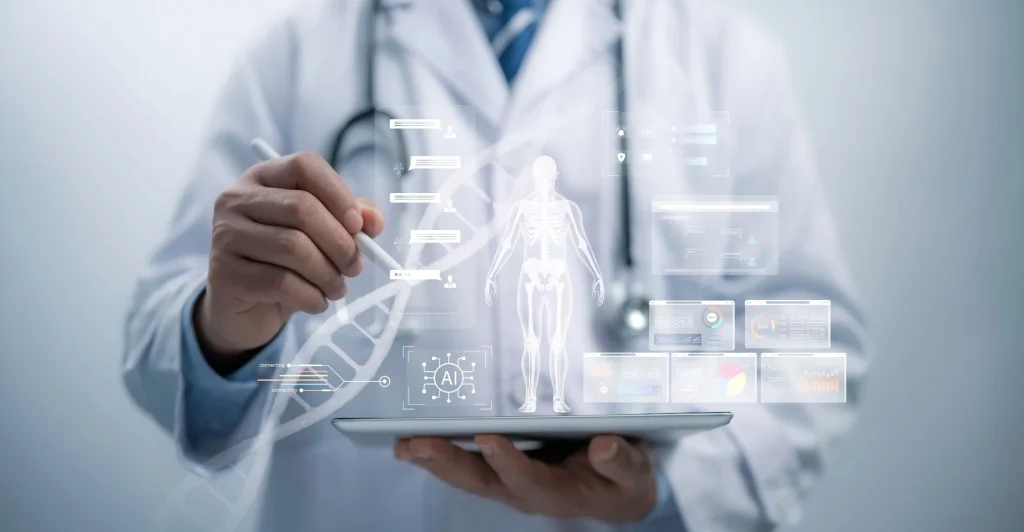Healthcare in 2025 is evolving faster than ever before, driven by technological innovation, shifting patient expectations, and the growing need for efficiency in overburdened health systems. From artificial intelligence (AI) and telemedicine to personalized treatments and preventive care, the medical field is embracing a future where care is smarter, faster, and more patient-centered. These advancements are not only improving outcomes but also reshaping how we view medicine as a whole.
The Rise of AI in Healthcare
Artificial intelligence has moved from theoretical discussions to practical applications across nearly every aspect of healthcare. Hospitals and clinics worldwide are adopting AI-powered tools to improve diagnostics, enhance treatment planning, and streamline administrative processes.
AI is proving particularly effective in medical imaging and diagnostics. Machine learning algorithms can now detect early signs of diseases such as cancer, heart disease, and neurological disorders with a level of precision that rivals or exceeds human experts. Radiologists, for example, use AI-assisted systems to analyze thousands of scans more quickly, reducing diagnostic errors and accelerating treatment timelines.
Beyond diagnostics, AI is transforming drug discovery. Traditionally, developing a new drug could take over a decade and billions of dollars. Today, AI-powered platforms can analyze vast datasets to predict how certain compounds will behave in the human body, dramatically cutting development time and cost.
While these advancements are promising, they raise questions about privacy, data security, and the ethical use of AI. Healthcare providers must balance innovation with patient trust, ensuring that sensitive medical data remains protected and that algorithms are free from bias.

Telemedicine Becomes the Norm
The COVID-19 pandemic accelerated the adoption of telemedicine, and by 2025, it has become a standard feature of most healthcare systems. Patients now expect to connect with their doctors virtually for routine consultations, follow-up visits, and even some diagnostic assessments.
Telemedicine offers clear benefits:
-
Increased access for patients in rural or underserved areas.
-
Reduced waiting times and travel burdens.
-
More efficient management of chronic conditions through regular virtual check-ins.
Specialists are also leveraging remote monitoring tools—wearable devices that track metrics like heart rate, oxygen levels, and glucose. These tools transmit data directly to doctors, allowing them to intervene before conditions worsen.
However, telemedicine also presents challenges. Not all patients have equal access to reliable internet or devices, and some conditions still require in-person evaluation. As healthcare systems continue to integrate virtual care, they must ensure it complements rather than replaces traditional methods, maintaining quality and equity.
Personalized and Precision Medicine
Gone are the days when medical treatments followed a one-size-fits-all approach. Advances in genomics and biotechnology have ushered in an era of personalized medicine, where treatments are tailored to an individual’s genetic profile, lifestyle, and environment.
Genetic testing allows doctors to predict disease risks, identify optimal treatments, and avoid adverse drug reactions. For example, in oncology, precision medicine is enabling physicians to match patients with therapies specifically designed to target the genetic mutations driving their cancer.
This approach not only improves treatment outcomes but also minimizes unnecessary interventions and side effects, offering patients a more effective and humane path to recovery.
Preventive Healthcare Takes Center Stage
As chronic diseases like diabetes, cardiovascular disease, and cancer continue to dominate global health concerns, there is a growing emphasis on prevention over treatment. Healthcare providers and governments are investing in programs designed to help people make healthier choices and detect diseases early.
Preventive healthcare includes:
-
Regular screenings for blood pressure, cholesterol, and cancer.
-
Vaccination programs to reduce infectious disease risks.
-
Public health campaigns promoting physical activity, balanced diets, and mental wellness.
The economic benefits are substantial. Preventing diseases reduces the strain on healthcare systems and lowers treatment costs. For patients, it translates into better quality of life and fewer medical crises.
Addressing Mental Health as a Core Priority
Mental health has emerged as a critical component of overall well-being, with healthcare systems integrating it into primary care rather than treating it as a separate issue. Rising rates of anxiety, depression, and stress-related disorders have led to broader acceptance of therapy, digital mental health apps, and workplace wellness initiatives.
In 2025, digital mental health platforms are bridging gaps in access, especially for those in remote or underserved areas. These platforms provide guided therapy, mindfulness exercises, and connections to licensed professionals. While they cannot fully replace in-person care, they are helping millions manage their mental health more effectively.
Tackling Global Health Inequalities
While medical technology is advancing rapidly, access remains uneven. Many low-income countries lack the infrastructure, funding, and trained personnel to implement these innovations. This disparity creates a two-tiered healthcare system, where advanced treatments are available in wealthier regions but remain inaccessible to much of the global population.
International organizations and partnerships are working to bridge these gaps. Mobile health (mHealth) initiatives, which deliver education and basic services via smartphones, are expanding rapidly. Efforts to train healthcare workers and distribute affordable medical technology are also making progress, though much work remains.
Climate Change and Health
Climate change is no longer just an environmental issue—it’s a public health crisis. Rising temperatures, poor air quality, and extreme weather events are fueling respiratory illnesses, heat-related conditions, and the spread of vector-borne diseases like dengue and malaria in new regions.
Healthcare providers are adapting by:
-
Developing climate-resilient facilities to withstand extreme weather.
-
Strengthening disease surveillance systems.
-
Promoting policies that reduce environmental impacts while safeguarding public health.
The healthcare sector itself is also adopting sustainable practices, from reducing energy consumption in hospitals to minimizing medical waste.
The Road Ahead
Healthcare in 2025 is defined by innovation, accessibility, and a shift toward holistic wellness. The integration of AI, telemedicine, personalized medicine, and preventive care is improving outcomes and efficiency. However, challenges such as global health disparities, ethical concerns around technology, and the impacts of climate change must be addressed to ensure these advancements benefit everyone.
Patients, providers, and policymakers all play a role in shaping this future. By embracing technology while prioritizing equity and sustainability, the medical field can continue to evolve toward a system that not only treats illness but actively promotes long-term health for all.

Conclusion
The medical field stands at the threshold of a new era. The innovations of 2025 are transforming healthcare into a more precise, accessible, and patient-focused system. Yet the success of these changes depends on responsible implementation, global cooperation, and a commitment to equity.
As the world faces ongoing health challenges—from chronic diseases to climate-driven risks—the future of medicine will hinge on our ability to balance innovation with humanity, ensuring that progress serves not just a few, but the entire global community.




